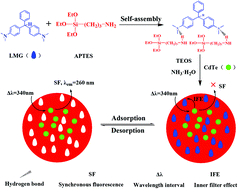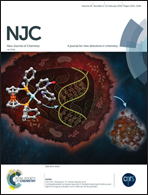Detection of trace leucomalachite green with a nanoprobe of CdTe quantum dots coated with molecularly imprinted silica via synchronous fluorescence quenching†
Abstract
A novel fluorescence nanoprobe using CdTe quantum dots as signal sources coated with a molecularly imprinted polymer was synthesized by a reverse microemulsion method. The nanoprobe was designed for the detection of leucomalachite green (LMG) in fish samples via synchronous fluorescence quenching based on the inner filter effect. LMG, (3-aminopropyl) triethoxysilane and tetraethyl orthosilicate were used as the template, functional monomer and cross-linker respectively in the probe. A synchronous fluorescence emission of the probe at 260 nm was observed when the wavelength interval was set as 340 nm, and the synchronous fluorescence could be linearly quenched with LMG at concentrations ranging from 0.1 to 20 μmol L−1. The as-prepared nanoprobes were nearly spherical with a diameter of about 50 nm. The detection limit was 23 nmol L−1 (3σ, n = 9) and the recoveries ranged from 96.2% to 104.9% for the fish samples. The results illustrated that the nanoprobe could be used for trace LMG measurement in fish samples.



 Please wait while we load your content...
Please wait while we load your content...